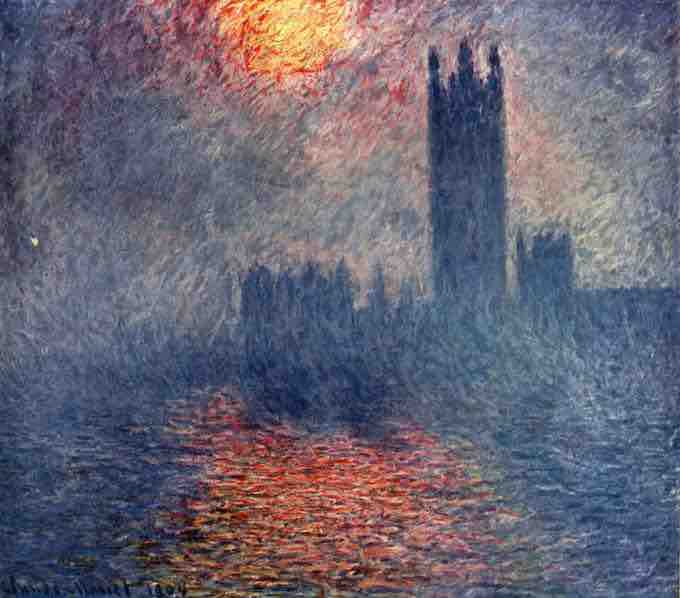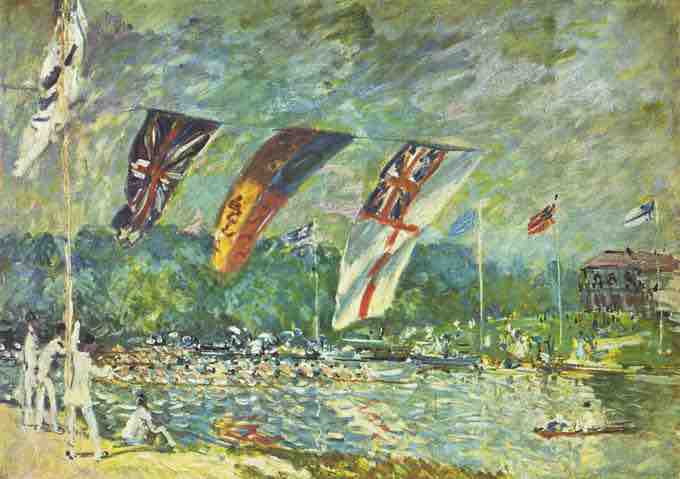Impressionism
Impressionism is a nineteenth century art movement that was originated by a group of Paris-based artists, including Berthe Morisot, Claude Monet, August Renoir, Edgar Degas, Camille Pissarro, and Alfred Sisley, as well as the American artist Mary Cassatt. These artists constructed their pictures with freely brushed colors that took precedence over lines and contours. They typically painted scenes of modern life and often painted outdoors. The Impressionists found that they could capture the momentary and transient effects of sunlight by painting en plein air. However, many Impressionist paintings and prints, especially those produced by Morisot and Cassatt, are set in domestic interiors. Typically, they portrayed overall visual effects instead of details, and used short, "broken" brush strokes of mixed and unmixed color to achieve an effect of intense color vibration.

London, Houses of Parliament. The Sun Shining through the Fog, Claude Monet, 1904
Monet is considered the most consistent and prolific practitioner of the Impressionist philosophy of expressing one's perceptions before nature.
Background
Radicals in their time, early impressionists violated the rules of academic painting. In 19th-century France, the Académie des Beaux-Arts ("Academy of Fine Arts") dominated French art. The Académie was the preserver of traditional French painting standards of content and style. Historical subjects, religious themes, and portraits were valued (landscape and still life were not), and the Académie preferred carefully finished images that looked realistic when examined closely. Color was somber and conservative, and traces of brush strokes were suppressed, concealing the artist's personality, emotions, and working techniques.
Impressionist painters could not afford to wait for France to accept their work, so they established their own exhibition—apart from the annual salon organized by the Académie. During the latter part of 1873, Monet, Renoir, Pissarro, and Sisley organized the Société Anonyme Coopérative des Artistes Peintres, Sculpteurs, Graveurs ("Cooperative and Anonymous Association of Painters, Sculptors, and Engravers") to exhibit their artworks independently. In total, thirty artists participated in their first exhibition, held in April 1874 at the studio of the French photographer and caricaturist Nadar.
The critical response was mixed. Critic and humorist Louis Leroy wrote a scathing review in the newspaper Le Charivari in which, making wordplay with the title of Claude Monet's Impression, soleil levant ("Impression, Sunrise"), he gave the artists the name by which they became known. The term "impressionists" quickly gained favor with the public. It was also accepted by the artists themselves, even though they were a diverse group in style and temperament, unified primarily by their spirit of independence and rebellion. They exhibited together eight times between 1874 and 1886. The individual artists achieved few financial rewards from the impressionist exhibitions, but their art gradually won a degree of public acceptance and support. Their dealer, Paul Durand-Ruel, played a major role in this as he kept their work before the public and arranged shows for them in London and New York.

Les régates à Moseley, Alfred Sisley, 1874, Oil on canvas
Sisley was dedicated to painting landscape en plein air and his work is known for capturing the transient effects of sunlight.
The Impressionists captured ordinary subjects, engaged in day to day activities in both rural and urban settings. Impressionist artists relaxed the boundary between subject and background so that the effect of an impressionist painting often resembles a snapshot, a part of a larger reality captured as if by chance.
The development of Impressionism can be considered partly as a reaction by artists to the challenge presented by photography, which seemed to devalue the artist's skill in reproducing reality. In spite of this, photography actually inspired artists to pursue other means of artistic expression, and rather than compete with photography to emulate reality, impressionists sought to express their perceptions of nature and modern city life.
Scenes from the bourgeois care-free lifestyle, as well as from the world of entertainment, such as cafés, dance halls, and theaters were among their favorite subjects. In their genre scenes of contemporary life, these artists tried to arrest a moment in their fast-paced lives by pinpointing specific atmospheric conditions—light flickering on water, moving clouds, city lights falling over dancing couples. Their technique tried to capture what they saw.

Camille Pissarro (1830–1903), Pontoise, 1867, Oil on canvas
Camille Pissarro was a stylistic forerunner of Impressionism known for his landscapes and for capturing the daily reality of village life.